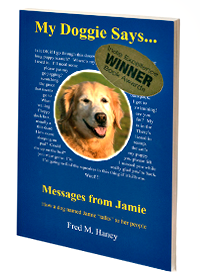My three-year-old granddaughter, Lauren, has a stinky. Actually she has about three stinkies, because one of them is usually so stinky that it needs to be washed. One-year-old Granddaughter Amelia has also started to use one of Lauren’s stinkies. The stinky, or security blanket was popularized by Linus in the Charles Schultz Peanuts cartoons. Psychologists call these things security objects.
Here, from Wikipedia, is some background on security objects. At least as they pertain to children. The article says that they can help children adapt to new situations and aid in their learning. This seems to work for dogs, too.
Jamie (My Doggie Says…) used a red, blue and yellow stuffed ball as her “stinky.” She kept it nearby most of the day. And at night, she often carried it into our bedroom to park it a few inches from her nose. She didn’t chew on it a lot; she just kept it close. Sometime, she talked to it in a high-pitch, whinie voice. But when her ball got lost forever, Jamie was depressed for several weeks. She had obviously lost an important part of her life. Here’s Jamie with her ball:
Callie’s stinky is her little stuffed dog. She carries it around and gently chews on it frequently. But especially at night. Almost every evening, she finds it and gently “gums” it just before bedtime. Sometimes for thirty or forty minutes. It seems to put her in a very peaceful mood — ready for a good night’s rest.
Several times, Callie has run down two flights of stairs to retrieve her stinky puppy. Then she comes back to living room to be with us while she enjoys her stinky. This morning, she was playing with it in our bedroom, and it got lost. I could tell she was looking for it, so I picked up some covers and a bedspread, but I couldn’t find it. Then I wondered if it was under the bed. I guess Callie had come to the same conclusion. By the time I could lift the bed skirt, Callie had stuck her six-month-old head under the bed and pulled out her puppy.
Callie does something with her stinky puppy that I’m not sure I understand. Jamie did the same thing. She will offer it to me, almost like a gift. I’ve seen her offer it to her doggie cousin Ishka, too. She offers it, but she doesn’t really let go. I’m reluctant to force her to “give” the puppy to me, because I don’t really think she intends to give it to me. And I don’t think she wants to get into a tug of war. So I usually hold onto it for a minute, while she’s still got it in her mouth. Then she seems happy to walk away and enjoy it again. It’s almost like she’s offering to share her most precious thing with me, but just a litle bit.
Watch your dog and see if you can figure out which toy is its stinky. Which toy does it play with the most? Which toy does it play with at bedtime? If it does have a stinky, then be aware that it might be extremely important to your dog’s good emotional balance to spend time with it. If it gets lost, help your dog find it. It will appreciate your help more than you can know.
This is an important way to build a closer relationship with your dog.













